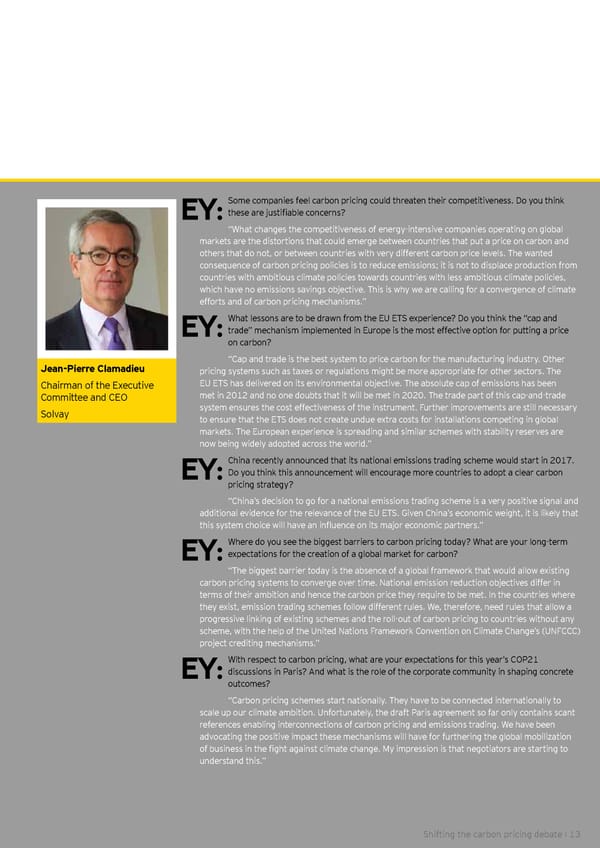Some companies feel carbon pricing could threaten their competitiveness. Do you think EY:these are justifiable concerns? “What changes the competitiveness of energy-intensive companies operating on global markets are the distortions that could emerge between countries that put a price on carbon and others that do not, or between countries with very different carbon price levels. The wanted consequence of carbon pricing policies is to reduce emissions; it is not to displace production from countries with ambitious climate policies towards countries with less ambitious climate policies, which have no emissions savings objective. This is why we are calling for a convergence of climate efforts and of carbon pricing mechanisms.” What lessons are to be drawn from the EU ETS experience? Do you think the “cap and EY:trade” mechanism implemented in Europe is the most effective option for putting a price on carbon? Jean-Pierre Clamadieu “Cap and trade is the best system to price carbon for the manufacturing industry. Other pricing systems such as taxes or regulations might be more appropriate for other sectors. The Chairman of the Executive EU ETS has delivered on its environmental objective. The absolute cap of emissions has been Committee and CEO met in 2012 and no one doubts that it will be met in 2020. The trade part of this cap-and-trade Solvay system ensures the cost effectiveness of the instrument. Further improvements are still necessary to ensure that the ETS does not create undue extra costs for installations competing in global markets. The European experience is spreading and similar schemes with stability reserves are now being widely adopted across the world.” China recently announced that its national emissions trading scheme would start in 2017. EY:Do you think this announcement will encourage more countries to adopt a clear carbon pricing strategy? “China’s decision to go for a national emissions trading scheme is a very positive signal and additional evidence for the relevance of the EU ETS. Given China’s economic weight, it is likely that this system choice will have an influence on its major economic partners.” Where do you see the biggest barriers to carbon pricing today? What are your long-term EY:expectations for the creation of a global market for carbon? “The biggest barrier today is the absence of a global framework that would allow existing carbon pricing systems to converge over time. National emission reduction objectives differ in terms of their ambition and hence the carbon price they require to be met. In the countries where they exist, emission trading schemes follow different rules. We, therefore, need rules that allow a progressive linking of existing schemes and the roll-out of carbon pricing to countries without any scheme, with the help of the United Nations Framework Convention on Climate Change’s (UNFCCC) project crediting mechanisms.” With respect to carbon pricing, what are your expectations for this year’s COP21 EY:discussions in Paris? And what is the role of the corporate community in shaping concrete outcomes? “Carbon pricing schemes start nationally. They have to be connected internationally to scale up our climate ambition. Unfortunately, the draft Paris agreement so far only contains scant references enabling interconnections of carbon pricing and emissions trading. We have been advocating the positive impact these mechanisms will have for furthering the global mobilization of business in the fight against climate change. My impression is that negotiators are starting to understand this.” Shifting the carbon pricing debate I 13 Shifting the carbon pricing debate I 13
 Shifting the Carbon Pricing Debate Page 12 Page 14
Shifting the Carbon Pricing Debate Page 12 Page 14